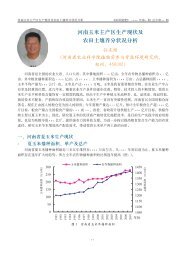Americas and Oceania Group - International Plant Nutrition Institute
Americas and Oceania Group - International Plant Nutrition Institute
Americas and Oceania Group - International Plant Nutrition Institute
You also want an ePaper? Increase the reach of your titles
YUMPU automatically turns print PDFs into web optimized ePapers that Google loves.
Global Maize Project in Russia: N. Tselina, Rostov Oblast<br />
Project Leader: O.A. Biryukova, Southern Federal University Department of Soil Science <strong>and</strong> L<strong>and</strong> Resources<br />
Evaluation, Rostov-on-Don, Rostov Oblast. E-mail: olga_alexan@mail.ru<br />
Project Cooperator: D.V. Bozhkov<br />
Maize was grown in 2011 after winter wheat at both the A-site <strong>and</strong> C-site. The potential yield was<br />
determined at the A-site, <strong>and</strong> thus the respective yield gap. We accessed what practices <strong>and</strong> inputs needed<br />
to be modified to narrow the yield gap. The current grower practice <strong>and</strong> the Ecological Intensification<br />
(EI) management system were compared for the site. On-farm experiments (C-site) were used to facilitate<br />
fine-tuning of the management systems <strong>and</strong> getting them in place on farmers’ fields. Initial soil properties<br />
indicate substantial soil nitrate (14.1 to 14.6 ppm in 0 to 20 cm layer), medium P extracted by a routine soil<br />
test (1% (NH 4 ) 2 CO 3 )—or “increased” (16 ppm P) according to new Olsen P soil-test interpretation classes<br />
proposed by researchers in Russia. The content of K extracted by 1% (NH 4 ) 2 CO 3 was considered high, <strong>and</strong> the<br />
exchangeable K level was very high (373 to 387 ppm).<br />
Grower fertilizer practice for maize (30 N 40 P) gave 8.12 t/ha grain at the A-site <strong>and</strong> “omission” of N<br />
fertilizer (9 N 40 P) resulted in 7.78 t/ha. No real zero N plots were tested since monoammonium phosphate<br />
(MAP) was used as a source of P. Ecological Intensification (EI) for maize (80 N 70 P 40 K) gave 8.77 t/<br />
ha, <strong>and</strong> “omission” of N (12 N 70 P 40 K) resulted in 8.33 t/ha. Grower fertilizer practice for soybean (20 N<br />
40 P) gave 1.92 t/ha at the A-site, <strong>and</strong> “omission” of N fertilizer (9 N 40 P) produced 1.86 t/ha. In soybean,<br />
EI (30 N 45 P 30 K) gave 2.27 t/ha, while “omission” of N (10 N 45 P 30 K) led to 2.12 t/ha. Ecological<br />
Intensification for soybean also resulted in higher protein content in grain (46.7%) compared with N<br />
“omission”(43.9%)—generating a maximum protein output of 1,060 kg/ha. The highest yield of maize at the<br />
C-site (8.98 t/ha) was obtained with ample NPK rates (100 N 80 P 60 K) <strong>and</strong> the control treatment gave 7.45<br />
t/ha. Thus, maize yield increased by 21% due to mineral fertilizer application. Nitrogen, P, <strong>and</strong> K fertilizer<br />
use at the C-site increased grain yield by 0.69 t/ha (8%), 1.05 t/ha (13%), <strong>and</strong> 0.56 t/ha (7%), respectively.<br />
Response to K fertilizer application indicates that perhaps soil-test K interpretation classes need to be adjusted<br />
<strong>and</strong> updated. IPNI-41<br />
Global Maize Project in Mexico: Celaya, Guanajuato<br />
Project Leader: Roberto Paredes, Instituto Nacional de Investigaciones Forestales, Agrícolas y Pecuarias (INIFAP),<br />
Colonia Roque Celaya, Guanajuato. E-mail: rparedesm59@prodigy.net.mx, paredes.roberto@inifap.gob.mx<br />
Project Cooperator: Benjamin Zamudio<br />
The study was started in 2009 in Celaya, State of Guanajuato, Mexico, at 1,830 meters above sea level. The<br />
treatment design included a combination of two management systems (plant populations) (Farmers’ practice<br />
[FP] <strong>and</strong> a higher population [EI]) <strong>and</strong> three N fertilization regimes (0-N, 300 kg N/ha applied two out of<br />
three years, <strong>and</strong> 300 kg N/ha applied every year). In 2011, the six treatments were: 1) 120,192 seeds/ha, 0-N;<br />
2) 120,192 seeds/ha, 300 kg N/ha (0 N in 2009; 300 kg N/ha in 2010); 3) 120,192 seeds/ha, 300 kg N/ha (300<br />
kg N/ha applied both in 2009 <strong>and</strong> 2010); 4) 90,580 seeds/ha, 0-N; 5) 2) 90,580 seeds/ha, 300 kg N/ha (0-N in<br />
2009; 300 kg N/ha in 2010); 6) 90,580 seeds/ha, 300 kg N/ha (300 kg N/ha applied both in 2009 <strong>and</strong> 2010).<br />
The first three treatments are considered as an intensification of the last three, which represent the traditional<br />
farmers’ practice.<br />
Yields responded to N, regardless of its application sequence. The application of 300 kg N/ha increased<br />
grain yields from an average of 1.9 t/ha to 10.9 t/ha, a reflection of significantly greater Harvest Index, more<br />
ears/ha, <strong>and</strong> larger ears with heavier kernels. Partial Factor Productivity <strong>and</strong> Agronomic Efficiency were 36<br />
<strong>and</strong> 30 kg grain/kg N, respectively. No significant differences in grain yield could be detected between the<br />
intensive <strong>and</strong> traditional management options, although plant population at harvest differed significantly<br />
between them: 91,600 vs. 68,900 plants/ha, respectively. By harvest time, the plant population under both<br />
management systems had decreased by 24% on average, which is higher than normal, especially under<br />
experimental conditions. Most of that loss (15%) had taken place by the third week after crop planting.<br />
IPNI-28<br />
Global Maize Project in Mexico: Toluca, México<br />
Project Leader: Benjamín Zamudio, González Instituto Nacional de Investigaciones Forestales, Agrícolas y Pecuarias<br />
(INIFAP), Toluca, México. E-mail: zamudio.benjamin@inifap.gob.mx<br />
The study was started in 2009 in Toluca, State of México, at an altitude of 2,370 meters above sea<br />
level. The objective was to compare the effects of six combinations of plant populations <strong>and</strong> fertilizer<br />
applications. Half of the treatments—labeled as intensive management—included high plant populations<br />
<strong>and</strong> the application of a complete fertilizer formula (90 kg P 2 O 5 /ha, 90 kg K 2 O/ha, 44 kg MgO/ha, 50 kg S/<br />
ha, <strong>and</strong> 3 kg Zn/ha). The remaining treatments were similar to current farmers’ practices with regards to plant<br />
IPNI Interpretive Summaries 11

















